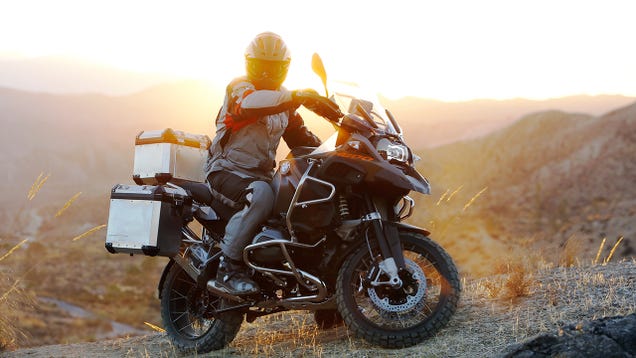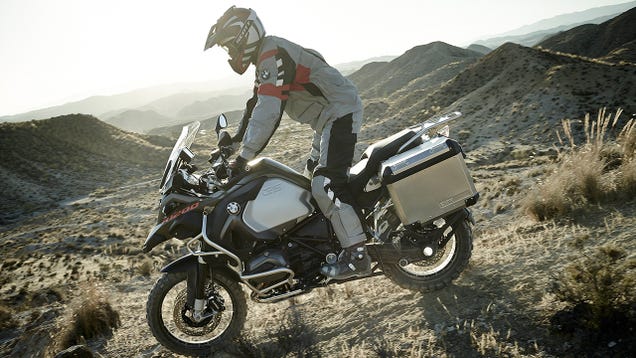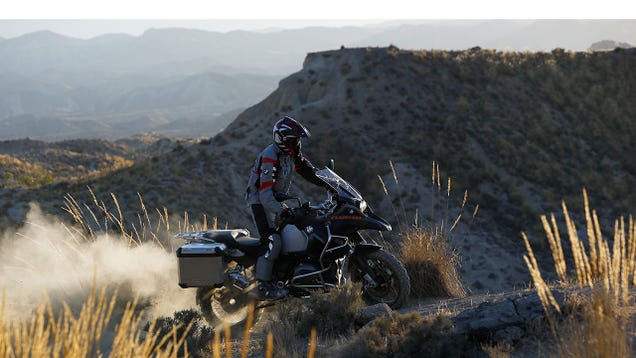How To Ride A Big, Heavy Motorcycle Off-Road

There's
no better way to see the world than from two wheels. But, the Adventure
Motorcycles made to do just that are so big and heavy, riding them off
the road becomes its own, separate and difficult-to-master skill. Here's
how to do it.
I've
learned all this the hard way. Growing up in England, my core competence
was always the sports bikes that are most popular there. The key with
those is to maximize grip, not encourage slides so, the American
predilection for dirt flummoxed me for many years. On my first big ADV
ride (across Nova Scotia, Newfoundland, Labrador and Quebec), I ate shit
in a pretty major way, giving myself a huge concussion that meant I
don't remember the next few days of the trip. Sadly that means I can't
tell you how to ride a BMW with a busted frame but, because I've learned
so much since then, I can tell you how to avoid that entire situation.
I've had to
work at this, and so will you. That crash in Labrador was way back in
2009 but now, five years later, I just completed a trip through British
Columbia. I was on the heaviest bike there and one of only two on road
tires, but I was the only person to avoid crashing the entire time. If I
can manage some semblance of competence on these things, you should be
able to figure it out pretty easily.
Let's
assume here that you already know how to generally ride a motorcycle,
either on the street or the road, and concentrate instead only on the
specific skills necessary for riding a big ADV machine, as exemplified
by the BMW R 1200 GS and its ilk.
Optimize Ergonomics:
Before riding one off road, you'll need to make it so you can stand
comfortably and securely for hours at a time, while having complete
control. First, put the motorcycle on its center stand or have a friend
hold it upright for you. Then, while standing upright on the pegs,
examine your reach to the bars. Can you reach them and move them
lock-to-lock without bending your back, slumping your shoulders or
otherwise contorting your body? If not, you can try and find more height
by rotating the bars forwards; if that's not enough, you'll need to
start buying new bars until you find ones that fit you. You also need to
be able to operate the clutch, brakes and shift lever while standing,
adjust them so that you can do so.
Also
consider the foot pegs. During an experimental ride close to home, try
and stand on them for 15 or 20 minutes straight in your usual riding
boots. How does that make your feet feel? Are there pressure points or
is anything uncomfortable? Most ADV bikes have foot pegs that are too
small for long term standing comfort and will need to be replaced with
larger, "bear trap" items from the aftermarket.
Standing
effectively lowers the motorcycle's center of gravity by putting your
weight through its pegs rather than the higher seat. It also turns you
into the world's least elegant cheetah tail. Yes, by awkwardly hovering
over the bike as it jumps around and slides, your beer belly will
actually help it stay upright and in motion. Always keep your knees
somewhat bent, your legs are your shock absorbers.
Once you
have a bike you can comfortably control over longer periods of time
while standing, you can move on to the rest of these skills.
Drop Your Pressures And Fit Good Tires:
Typical road tire pressures are 36psi (front) and 42psi (rear).
Off-road, you'll want to go much lower. 20psi is a good compromise
pressure at both ends if you need to hit both tarmac and dirt in the
same day, but for off-road use only, I'll go as low as 12psi. Consider
what type of wheels you have before doing this. Cast aluminum wheels as
found on the cheaper, more road-oriented bikes are weaker, meaning you
need to protect them from impacts and keep the tires at 20psi. Spoked
wheels are stronger and better resist deformation and allow you to
"true" them back into shape if you do ding them, so they facilitate
those lower pressures. A lower pressure tire will be less able to
cushion the wheel from impacts, such as hitting a large rock.
Look
closely at any ADV bike you see in an ad, magazine or video where it's
jumping, sliding or doing anything ambitious on dirt. See those large
tread blocks? Those are Continental TKC80s, by far the most capable ADV
tire. But, they're expensive and don't last much over 2,500 miles.
Rawhyde sells a knock off that's both cheaper and longer lasting. We've
heard good things.
Stay Off The Clutch:
The advantage of carrying such large, 800 or 1,200cc motors is that
these bikes have massive torque delivered low down in the rev range.
Basically form idle. That means you can walk them over or around walking
speed obstacles without using the clutch. Doing so gives you better
control of the motorcycle and is less fatiguing. But, you'll need to
practice to achieve smoothness, do that.
Except For Wheelies:
To clear obstacles like large rocks, logs, the lips of desert washes
and the climbs out of streams, you'll need to be able to hoist the front
wheel on-demand. With your pink and ring finger wrapped around the bar,
use your middle and pointer finger to quickly whip in the clutch lever,
roll on the throttle with the other hand and quickly, with with
control, release the clutch. That should get your front end up on one of
these beasts without a problem.
Got a slide
about to go way wrong? Stomp on the peg on the side the bike is sliding
towards to bring it back into line. Stomp hard. It's the same principal
as counter-steering and it works.

Master The Front Brake: While
standing, bend at the hip like you're doing a squat, forcing your but
as far rearwards and as low as possible. If it feels like you're about
to sit on the luggage rack behind the passenger seat, you're doing it
right. This should allow you to transfer your weight through your arms,
into the bars and down to the front tire to give it its maximum possible
chance at finding traction while braking hard. As on the road, squeeze
softly initially to load its contact patch, before progressively moving
your way up to full braking power.
Find an
empty area and practice maintaining control while locking the front
brake. It's dangerous, but one way to do this is to stay on the
throttle, pushing the locked front wheel around while you try to keep
the bike upright. If you choose to practice that way, please be aware
that you will at some point crash, hopefully both you and the bike are
prepared for that.

Leave The Electronics On: These
are some big, heavy bikes. Ready-to-ride, but before fitting luggage,
that SuperTenere I rode through Canada weighs 636lbs! That's heavy for
the class, but even the lightest ADV bikes typically remain 500lbs plus.
That means we're talking about a ton of momentum which means things can
go wrong very quickly and quite irrevocably. Fortunately, most of these
bikes now come with ABS and Traction Control optimized to work
off-road. Practice with yours in a safe environment, learning which
settings work best in which conditions and under what circumstances you
may want to turn them off.
ABS is a
wonderful safety aid on an ADV bike, allowing you to get on the brakes
hard if a cow suddenly jumps into the road while you're head is off in
the clouds. But, it's going to work against you on steep downhills in
loose sand or dirt. So learn where it works, consider the terrain you're
riding through and switch it on and off as you ride accordingly.
TC is the
same, reigning in slides before they require too much intervention from
us humans. But, try and climb a steep hill through loose sand or dirt or
mud and, well, you're not going anywhere. Again, learn its function and
use it accordingly.
Don't think
you're too manly to use these electronic rider aids. ADV riding often
involves very long days in very bad weather through very dangerous
terrain. And that spells fatigue. Take it from me, crashing five days
from the nearest hospital or mechanic is a bad idea and take advantage
of any help you can get in not doing that.
Want to learn more? Schools dedicated to these skills are operated by both Rawhyde (in California) and Jimmy Lewis (in Nevada). Go to them, they work.
No comments:
Post a Comment